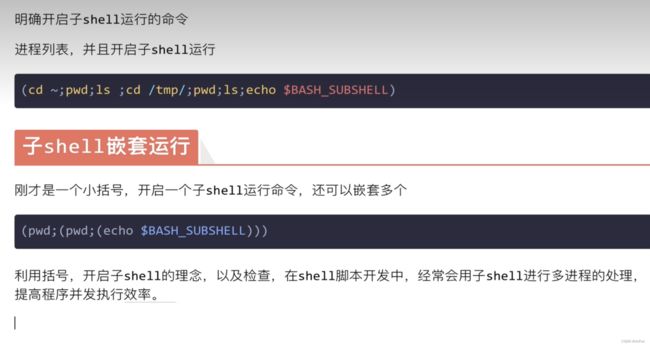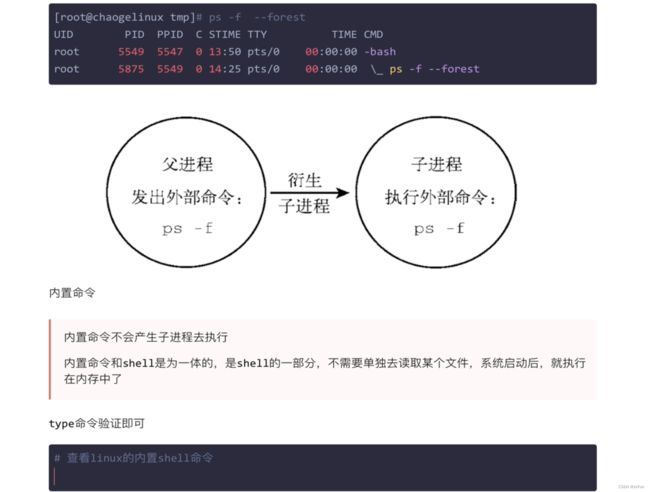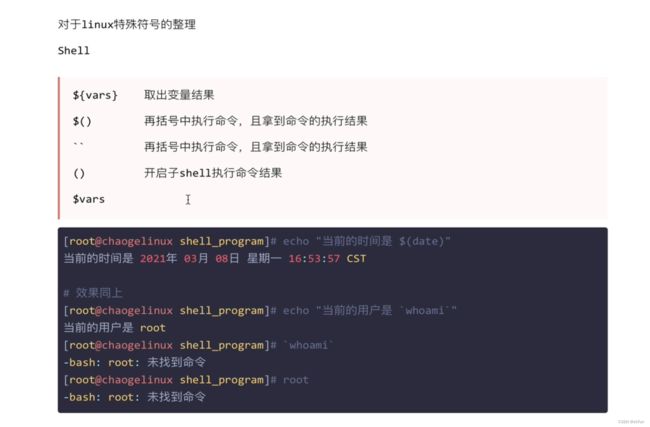Linux进阶之Shell
文章目录
- Linux分为三大部分【1.基础理论】【2.常用指令】【3.Shell编程】
- 1 Shell概述
- 2 Shell解析器
- 3 Shell脚本入门
-
- 3.1 脚本格式
- 3.2 第一个Shell脚本:helloworld
- 3.3 父子shell
-
- () :开启子shell执行
- \${} == $vars 取变量结果、\$() == \` ` shell命令执行后取结果
- 3.3 第二个Shell脚本:多命令处理
- 4 Shell中的变量
-
- 4.1 系统变量显示set、env、declare、export
- 4.2 自定义变量set、unset、readonly
- 4.3 $n (取第几个参数)
- 4.4 $#(添加到shell当中参数的个数)
- 4.5 \$*、\$@ (所有参数)
- 4.6 $?(最后一次执行的命令的返回状态)
- 4.7 $!(返回最近一次执行的ID号)
- 4.8 $$(脚本运行的当前进程ID号)
- 5 运算符\$[] 和 \$(())、expr
- 6 命令替换 $()和\` \`
- 6 条件判断 test 和 []、扩展[[]]、(())
- 7 流程控制(重点)
-
- 7.1 if 判断
- 7.2 case 语句
- 7.3 for 循环
- 7.4 while 循环
- 8 read读取控制台输入
- 9 函数
-
- 9.1 系统函数
- 9.2 自定义函数
- 9.3 函数执行,return和exit
- 10 Shell工具(重点)
-
- 10.1 cut
- 10.2 sed⭐
- 10.3 awk
- 10.4 sort
- 10.5 <、>、 <<、 >>
- 10.6 ==()、 (())、[]、[[]]、{} 总结==
- 11企业面试题(重点)
-
- 11.1 使用Linux命令查询file1中空行所在的行号
- 11.2 使用Linux命令计算txt第二列的和并输出
- 11.3 Shell脚本里如何检查一个文件是否存在?如果不存在该如何处理?
- 11.4 用shell写一个脚本,对文本中无序的一列数字排序
- 11.5 请用shell脚本写出查找当前文件夹(/home)下所有的文本文件内容中包含有字符”shen”的文件名称
Linux分为三大部分【1.基础理论】【2.常用指令】【3.Shell编程】
本文为第三部分【Shell编程】
第一部分【基础理论】
第二部分【常用指令】
本文为尚硅谷学习笔记,视频学习链接
需要一定的linux知识和指令学习基础。
1 Shell概述
Shell是一个命令行解释器,它接收应用程序/用户命令,然后调用操作系统内核。
Shell还是一个功能相当强大的编程语言,易编写、易调试、灵活性强。

2 Shell解析器
Shell解析器
-
Linux提供的Shell解析器有:
[atguigu@hadoop101 ~]$ cat /etc/shells /bin/sh /bin/bash /sbin/nologin /bin/dash /bin/tcsh /bin/csh echo $SHELL /bin/zsh -
bash和sh的关系
[atguigu@hadoop101 bin]$ ll | grep bash -rwxr-xr-x. 1 root root 941880 5月 11 2016 bash lrwxrwxrwx. 1 root root 4 5月 27 2017 sh -> bash -
Centos默认的解析器是bash
[atguigu@hadoop102 bin]$ echo $SHELL /bin/bash
3 Shell脚本入门
3.1 脚本格式
脚本以#!/bin/bash开头(指定解析器)
3.2 第一个Shell脚本:helloworld
-
需求:创建一个Shell脚本,输出helloworld
-
案例实操:
[atguigu@hadoop101 datas]$ touch helloworld.sh [atguigu@hadoop101 datas]$ vi helloworld.sh在helloworld.sh中输入如下内容
#!/bin/bash echo "helloworld" -
脚本的常用执行方式
-
bash、./xx.sh 执行:开启
子shell执行后 退出 -
source xx.sh、. xx.sh
当前shell执行(1)采用bash或sh+脚本的相对路径或绝对路径(不用赋予脚本+x权限)
sh+脚本的相对路径
[atguigu@hadoop101 datas]$ sh helloworld.sh Helloworldsh+脚本的绝对路径
[atguigu@hadoop101 datas]$ sh /home/atguigu/datas/helloworld.sh helloworldbash+脚本的相对路径
[atguigu@hadoop101 datas]$ bash helloworld.sh Helloworldbash+脚本的绝对路径
[atguigu@hadoop101 datas]$ bash /home/atguigu/datas/helloworld.sh Helloworld(2)采用输入脚本的绝对路径或相对路径执行脚本(必须具有可执行权限+x)
(a)首先要赋予helloworld.sh 脚本的+x权限[atguigu@hadoop101 datas]$ chmod 777 helloworld.sh(b)执行脚本
相对路径
[atguigu@hadoop101 datas]$ ./helloworld.sh Helloworld绝对路径
[atguigu@hadoop101 datas]$ /home/atguigu/datas/helloworld.sh Helloworld注意:第一种执行方法,本质是bash解析器帮你执行脚本,所以脚本本身不需要执行权限。第二种执行方法,本质是脚本需要自己执行,所以需要执行权限。
source = . 执行,使用当前shell执行sh文件
3.3 父子shell
() :开启子shell执行
${} == $vars 取变量结果、$() == ` ` shell命令执行后取结果
3.3 第二个Shell脚本:多命令处理
(1)需求:
在/home/atguigu/目录下创建一个banzhang.txt,在banzhang.txt文件中增加“I love cls”。
(2)案例实操:
[atguigu@hadoop101 datas]$ touch batch.sh
[atguigu@hadoop101 datas]$ vi batch.sh
在batch.sh中输入如下内容
#!/bin/bash
cd /home/atguigu
touch cls.txt
echo "I love cls" >>cls.txt
4 Shell中的变量
4.1 系统变量显示set、env、declare、export
- 常用系统变量
$HOME、$PWD、$SHELL、$USER等 - 案例实操
(1)查看系统变量的值
(2)显示当前Shell中所有变量:set[atguigu@hadoop101 datas]$ echo $HOME /home/atguigu[atguigu@hadoop101 datas]$ set BASH=/bin/bash BASH_ALIASES=() BASH_ARGC=() BASH_ARGV=()
4.2 自定义变量set、unset、readonly
-
基本语法
(1)定义变量:变量=值
(2)撤销变量:unset 变量
(3)声明静态变量:readonly变量,注意:不能unset -
变量定义规则
(1)变量名称可以由字母、数字和下划线组成,但是不能以数字开头,环境变量名建议大写。
(2)等号两侧不能有空格
(3)在bash中,变量默认类型都是字符串类型,无法直接进行数值运算。
(4)变量的值如果有空格,需要使用双引号或单引号括起来。 -
案例实操
(1)定义变量A[atguigu@hadoop101 datas]$ A=5 [atguigu@hadoop101 datas]$ echo $A 5(2)给变量A重新赋值
[atguigu@hadoop101 datas]$ A=8 [atguigu@hadoop101 datas]$ echo $A 8(3)撤销变量A
[atguigu@hadoop101 datas]$ unset A [atguigu@hadoop101 datas]$ echo $A(4)声明静态的变量B=2,不能unset
[atguigu@hadoop101 datas]$ readonly B=2 [atguigu@hadoop101 datas]$ echo $B 2 [atguigu@hadoop101 datas]$ B=9 -bash: B: readonly variable(5)在bash中,变量默认类型都是字符串类型,无法直接进行数值运算
[atguigu@hadoop102 ~]$ C=1+2 [atguigu@hadoop102 ~]$ echo $C 1+2(6)变量的值如果有空格,需要使用双引号或单引号括起来
[atguigu@hadoop102 ~]$ D=I love banzhang -bash: world: command not found [atguigu@hadoop102 ~]$ D="I love banzhang" [atguigu@hadoop102 ~]$ echo $A I love banzhang(7)可把变量提升为全局环境变量,可供其他Shell程序使用
export 变量名 [atguigu@hadoop101 datas]$ vim helloworld.sh在helloworld.sh文件中增加echo $B
#!/bin/bash echo "helloworld" echo $B[atguigu@hadoop101 datas]$ ./helloworld.sh Helloworld发现并没有打印输出变量B的值。
[atguigu@hadoop101 datas]$ export B [atguigu@hadoop101 datas]$ ./helloworld.sh helloworld 2
4.3 $n (取第几个参数)
-
基本语法
$n(功能描述:n为数字,$0代表该脚本名称,$1 - $9代表第一到第九个参数,十以上的参数,十以上的参数需要用大括号包含,如${10}) -
案例实操
(1)输出该脚本文件名称、输入参数1和输入参数2 的值[atguigu@hadoop101 datas]$ touch parameter.sh [atguigu@hadoop101 datas]$ vim parameter.sh#!/bin/bash echo "$0 $1 $2"[atguigu@hadoop101 datas]$ chmod 777 parameter.sh [atguigu@hadoop101 datas]$ ./parameter.sh cls xz ./parameter.sh cls xz
4.4 $#(添加到shell当中参数的个数)
-
基本语法
$#(功能描述:获取所有输入参数个数,常用于循环)。 -
案例实操
(1)获取输入参数的个数[atguigu@hadoop101 datas]$ vim parameter.sh#!/bin/bash echo "$0 $1 $2" echo $#[atguigu@hadoop101 datas]$ chmod 777 parameter.sh [atguigu@hadoop101 datas]$ ./parameter.sh cls xz parameter.sh cls xz 2
4.5 $*、$@ (所有参数)
-
基本语法
$*(功能描述:这个变量代表命令行中所有的参数,$*把所有的参数看成一个整体)$@(功能描述:这个变量也代表命令行中所有的参数,不过$@把每个参数区分对待) -
案例实操
(1)打印输入的所有参数[atguigu@hadoop101 datas]$ vim parameter.sh#!/bin/bash echo "$0 $1 $2" echo $# echo $* echo $@[atguigu@hadoop101 datas]$ bash parameter.sh 1 2 3 parameter.sh 1 2 3 1 2 3 1 2 3
4.6 $?(最后一次执行的命令的返回状态)
-
基本语法
$?(功能描述:最后一次执行的命令的返回状态。如果这个变量的值为0,证明上一个命令正确执行;如果这个变量的值为非0(具体是哪个数,由命令自己来决定),则证明上一个命令执行不正确了。) -
案例实操
(1)判断helloworld.sh脚本是否正确执行[atguigu@hadoop101 datas]$ ./helloworld.sh hello world[atguigu@hadoop101 datas]$ echo $? 0
4.7 $!(返回最近一次执行的ID号)
- 基本语法
$!返回最近一次执行的pid
4.8 $$(脚本运行的当前进程ID号)
- 基本语法
$!返回最近一次执行的pid
5 运算符$[] 和 $(())、expr
-
基本语法
(1)“$((运算式))”或“$[运算式]”
(2)expr + , - , \*, /, %加,减,乘,除,取余
注意:expr运算符间要有空格 -
案例实操:
(1)计算3+2的值[atguigu@hadoop101 datas]$ expr 2 + 3 5(2)计算3-2的值
[atguigu@hadoop101 datas]$ expr 3 - 2 1(3)计算(2+3)X4的值
-
expr一步完成计算
[atguigu@hadoop101 datas]$ expr `expr 2 + 3` \* 4 20 -
采用$[运算式]方式
[atguigu@hadoop101 datas]# S=$[(2+3)*4] [atguigu@hadoop101 datas]# echo $S
-
6 命令替换 $()和` `
-
基本语法
在$()和` ` 执行shell命令 -
案例实操:
#!/bin/bash testing=$(date) echo "The date and time are:" $testing # [root@web01 ~]./test.sh The date and time are: Mon Sep 28 10:31:39 CST 2020[root@web01 ~]cat test.sh #!/bin/bash # copy the /usr/bin directory listing to a log file today=$(date +%y%m%d) ls /usr/bin -al > log.$today today [root@web01 ~]./test.sh [root@web01 ~]cat log.200928 |wc -l 1240[root@web01 ~]echo `date '--date=1 hour ago' +%Y-%m-%d-%H` 2020-09-28-10 [root@web01 ~]echo $(date '--date=1 hour ago' +%Y-%m-%d-%H) 2020-09-28-10
6 条件判断 test 和 []、扩展[[]]、(())
- 基本语法
[ condition ](注意condition前后要有空格)
注意:条件非空即为true,[ atguigu ]返回true,[] 返回false。
-
常用判断条件
(1)两个整数之间比较=字符串比较
-lt小于(less than)
-le小于等于(less equal)
-eq等于(equal)
-gt大于(greater than)
-ge大于等于(greater equal)
-ne不等于(Not equal)(2)按照文件权限进行判断
-r有读的权限(read)
-w有写的权限(write)
-x有执行的权限(execute)(3)按照文件类型进行判断
-f文件存在并且是一个常规的文件(file)
-e文件存在(existence)
-d文件存在并是一个目录(directory) -
案例实操
(1)23是否大于等于22[atguigu@hadoop101 datas]$ [ 23 -ge 22 ] [atguigu@hadoop101 datas]$ echo $? 0(2)helloworld.sh是否具有写权限
[atguigu@hadoop101 datas]$ [ -w helloworld.sh ] [atguigu@hadoop101 datas]$ echo $? 0(3)/home/atguigu/cls.txt目录中的文件是否存在
[atguigu@hadoop101 datas]$ [ -e /home/atguigu/cls.txt ] [atguigu@hadoop101 datas]$ echo $? 1(4)多条件判断,串行执行(
&&表示前一条命令执行成功时,才执行后一条命令,||表示上一条命令执行失败后,才执行下一条命令)[atguigu@hadoop101 ~]$ [ condition ] && echo OK || echo notok OK [atguigu@hadoop101 datas]$ [ condition ] && [ ] || echo notok notok
7 流程控制(重点)
7.1 if 判断
-
基本语法
if [ 条件判断式 ];then 程序 fi或者
if [ 条件判断式 ] then 程序 fi注意事项:
(1)[ 条件判断式 ],中括号和条件判断式之间必须有空格
(2)if后要有空格 -
案例实操
(1)输入一个数字,如果是1,则输出banzhang zhen shuai,如果是2,则输出cls zhen mei,如果是其它,什么也不输出。[atguigu@hadoop101 datas]$ touch if.sh [atguigu@hadoop101 datas]$ vim if.sh#!/bin/bash if [ $1 -eq "1" ] then echo "banzhang zhen shuai" elif [ $1 -eq "2" ] then echo "cls zhen mei" fi[atguigu@hadoop101 datas]$ chmod 777 if.sh [atguigu@hadoop101 datas]$ ./if.sh 1 banzhang zhen shuai
7.2 case 语句
-
基本语法
case $变量名 in "值1") 如果变量的值等于值1,则执行程序1 ;; "值2") 如果变量的值等于值2,则执行程序2 ;; …省略其他分支… *) 如果变量的值都不是以上的值,则执行此程序 ;; esac注意事项:
- case行尾必须为单词“in”,每一个模式匹配
必须以右括号“)”结束。 双分号“;;”表示命令序列结束,相当于java中的break。最后的“*)”表示默认模式,相当于java中的default。
- case行尾必须为单词“in”,每一个模式匹配
-
案例实操
(1)输入一个数字,如果是1,则输出banzhang,如果是2,则输出cls,如果是其它,输出renyao。[atguigu@hadoop101 datas]$ touch case.sh [atguigu@hadoop101 datas]$ vim case.sh!/bin/bash case $1 in "1") echo "banzhang" ;; "2") echo "cls" ;; *) echo "renyao" ;; esac[atguigu@hadoop101 datas]$ chmod 777 case.sh [atguigu@hadoop101 datas]$ ./case.sh 1 1
7.3 for 循环
-
基本语法1
类似于javafor (( 初始值;循环控制条件;变量变化 )) do 程序 done -
案例实操
(1)从1加到100[atguigu@hadoop101 datas]$ touch for1.sh [atguigu@hadoop101 datas]$ vim for1.sh#!/bin/bash s=0 for((i=0;i<=100;i++)) do s=$[$s+$i] done echo $s[atguigu@hadoop101 datas]$ chmod 777 for1.sh [atguigu@hadoop101 datas]$ ./for1.sh “5050” -
基本语法2
遍历数组/输入集合for 变量 in 值1 值2 值3… do 程序 done -
案例实操
(1)打印所有输入参数[atguigu@hadoop101 datas]$ touch for2.sh [atguigu@hadoop101 datas]$ vim for2.sh#!/bin/bash #打印数字 for i in $* do echo "ban zhang love $i " done[atguigu@hadoop101 datas]$ chmod 777 for2.sh [atguigu@hadoop101 datas]$ bash for2.sh cls xz bd ban zhang love cls ban zhang love xz ban zhang love bd(2)比较 ∗ 和 *和 ∗和@区别
(a) ∗ 和 *和 ∗和@都表示传递给函数或脚本的所有参数,不被双引号“”包含时,都以$1 2 … 2 … 2…n的形式输出所有参数。[atguigu@hadoop101 datas]$ touch for.sh [atguigu@hadoop101 datas]$ vim for.sh#!/bin/bash for i in $* do echo "ban zhang love $i " done for j in $@ do echo "ban zhang love $j" done[atguigu@hadoop101 datas]$ bash for.sh cls xz bd ban zhang love cls ban zhang love xz ban zhang love bd ban zhang love cls ban zhang love xz ban zhang love bd(b)
当它们被双引号“”包含时不同,“$*”会将所有的参数作为一个整体,以“$1 2 … 2 … 2…n”的形式输出所有参数;“$@”会将各个参数分开,以“$1” “ 2 ” … ” 2”…” 2”…”n”的形式输出所有参数。[atguigu@hadoop101 datas]$ vim for.sh#!/bin/bash for i in "$*" #$*中的所有参数看成是一个整体,所以这个for循环只会循环一次 do echo "ban zhang love $i" done for j in "$@" #$@中的每个参数都看成是独立的,所以“$@”中有几个参数,就会循环几次 do echo "ban zhang love $j" done[atguigu@hadoop101 datas]$ chmod 777 for.sh [atguigu@hadoop101 datas]$ bash for.sh cls xz bd ban zhang love cls xz bd ban zhang love cls ban zhang love xz ban zhang love bd
7.4 while 循环
1.基本语法
while [ 条件判断式 ]
do
程序
done
2.案例实操
(1)从1加到100
[atguigu@hadoop101 datas]$ touch while.sh
[atguigu@hadoop101 datas]$ vim while.sh
#!/bin/bash
s=0
i=1
while [ $i -le 100 ]
do
s=$[$s+$i]
i=$[$i+1]
done
echo $s
[atguigu@hadoop101 datas]$ chmod 777 while.sh
[atguigu@hadoop101 datas]$ ./while.sh
5050
8 read读取控制台输入
-
基本语法
read(选项)(参数)选项:
-p:指定读取值时的提示符;
-t:指定读取值时等待的时间(秒)。
参数
变量:指定读取值的变量名 -
案例实操
(1)提示7秒内,读取控制台输入的名称[atguigu@hadoop101 datas]$ touch read.sh [atguigu@hadoop101 datas]$ vim read.sh#!/bin/bash read -t 7 -p "Enter your name in 7 seconds " NAME echo $NAME[atguigu@hadoop101 datas]$ ./read.sh Enter your name in 7 seconds xiaoze xiaoze
9 函数
9.1 系统函数
-
basename基本语法
basename [string / pathname] [suffix](功能描述:basename命令会删掉所有的前缀包括最后一个(‘/’)字符,然后将字符串显示出来。
选项:
suffix为后缀,如果suffix被指定了,basename会将pathname或string中的suffix去掉。 -
案例实操
(1)截取该/home/atguigu/banzhang.txt路径的文件名称[atguigu@hadoop101 datas]$ basename /home/atguigu/banzhang.txt banzhang.txt [atguigu@hadoop101 datas]$ basename /home/atguigu/banzhang.txt .txt banzhang -
dirname基本语法
dirname 文件绝对路径(功能描述:从给定的包含绝对路径的文件名中去除文件名(非目录的部分),然后返回剩下的路径(目录的部分)) -
案例实操
(1)获取banzhang.txt文件的路径[atguigu@hadoop101 ~]$ dirname /home/atguigu/banzhang.txt /home/atguigu
9.2 自定义函数
- 基本语法
[ function ] funname[()]
{
Action;
[return int;]
}
funname
-
经验技巧
(1)必须在调用函数地方之前,先声明函数,shell脚本是逐行运行。不会像其它语言一样先编译。
(2)函数返回值,只能通过$?系统变量获得,可以显示加:return返回,如果不加,将以最后一条命令运行结果,作为返回值。return后跟数值n(0-255) -
案例实操
(1)计算两个输入参数的和[atguigu@hadoop101 datas]$ touch fun.sh [atguigu@hadoop101 datas]$ vim fun.sh#!/bin/bash function sum() { s=0 s=$[ $1 + $2 ] echo "$s" } read -p "Please input the number1: " n1; read -p "Please input the number2: " n2; sum $n1 $n2;[atguigu@hadoop101 datas]$ chmod 777 fun.sh [atguigu@hadoop101 datas]$ ./fun.sh Please input the number1: 2 Please input the number2: 5 7
9.3 函数执行,return和exit
10 Shell工具(重点)
10.1 cut
cut的工作就是“剪”,具体的说就是在文件中负责剪切数据用的。cut 命令从文件的每一行剪切字节、字符和字段并将这些字节、字符和字段输出。
-
基本用法
cut [选项参数] filename说明:默认分隔符是制表符
-
选项参数说明
-f列号,提取第几列
-d分隔符,按照指定分隔符分割列 -
案例实操
(0)数据准备[atguigu@hadoop101 datas]$ touch cut.txt [atguigu@hadoop101 datas]$ vim cut.txt dong shen guan zhen wo wo lai lai le le(1)切割cut.txt第一列
[atguigu@hadoop101 datas]$ cut -d " " -f 1 cut.txt dong guan wo lai le(2)切割cut.txt第二、三列
[atguigu@hadoop101 datas]$ cut -d " " -f 2,3 cut.txt shen zhen wo lai le(3)在cut.txt文件中切割出guan
[atguigu@hadoop101 datas]$ cat cut.txt | grep "guan" | cut -d " " -f 1 guan(4)选取系统PATH变量值,第2个“:”开始后的所有路径:
[atguigu@hadoop101 datas]$ echo $PATH /usr/lib64/qt-3.3/bin:/usr/local/bin:/bin:/usr/bin:/usr/local/sbin:/usr/sbin:/sbin:/home/atguigu/bin[atguigu@hadoop102 datas]$ echo $PATH | cut -d: -f 2- /usr/local/bin:/bin:/usr/bin:/usr/local/sbin:/usr/sbin:/sbin:/home/atguigu/bin(5)切割ifconfig 后打印的IP地址
[atguigu@hadoop101 datas]$ ifconfig eth0 | grep "inet addr" | cut -d: -f 2 | cut -d" " -f1 192.168.1.102
10.2 sed⭐
依稀记得面试考过
sed是一种流编辑器,它一次处理一行内容。处理时,把当前处理的行存储在临时缓冲区中,称为“模式空间”,接着用sed命令处理缓冲区中的内容,处理完成后,把缓冲区的内容送往屏幕。接着处理下一行,这样不断重复,直到文件末尾。文件内容并没有改变,除非你使用重定向存储输出。
-
基本用法
sed [选项参数] ‘command’ filename -
选项参数说明
-e直接在指令列模式上进行sed的动作编辑。 -
命令功能描述
a新增,a的后面可以接字串,在下一行出现
d删除
s查找并替换 -
案例实操
(0)数据准备[atguigu@hadoop102 datas]$ touch sed.txt [atguigu@hadoop102 datas]$ vim sed.txt dong shen guan zhen wo wo lai lai le le(1)将“mei nv”这个单词插入到sed.txt第二行下,打印。
[atguigu@hadoop102 datas]$ sed '2a mei nv' sed.txt dong shen guan zhen mei nv wo wo lai lai le le[atguigu@hadoop102 datas]$ cat sed.txt dong shen guan zhen wo wo lai lai le le注意:文件并没有改变
(2)删除sed.txt文件所有包含wo的行[atguigu@hadoop102 datas]$ sed '/wo/d' sed.txt dong shen guan zhen lai lai le le(3)将sed.txt文件中wo替换为ni
[atguigu@hadoop102 datas]$ sed 's/wo/ni/g' sed.txt dong shen guan zhen ni ni lai lai le le注意:‘g’表示global,全部替换
(4)将sed.txt文件中的第二行删除并将wo替换为ni[atguigu@hadoop102 datas]$ sed -e '2d' -e 's/wo/ni/g' sed.txt dong shen ni ni lai lai le le
10.3 awk
一个强大的文本分析工具,把文件逐行的读入,以空格为默认分隔符将每行切片,切开的部分再进行分析处理。
-
基本用法
awk [选项参数] ‘pattern1{action1} pattern2{action2}...’ filenamepattern:表示AWK在数据中查找的内容,就是匹配模式
action:在找到匹配内容时所执行的一系列命令 -
选项参数说明
-F指定输入文件折分隔符
-v赋值一个用户定义变量 -
案例实操
(0)数据准备[atguigu@hadoop102 datas]$ sudo cp /etc/passwd ./(1)搜索passwd文件以root关键字开头的所有行,并输出该行的第7列。
[atguigu@hadoop102 datas]$ awk -F: '/^root/{print $7}' passwd /bin/bash(2)搜索passwd文件以root关键字开头的所有行,并输出该行的第1列和第7列,中间以“,”号分割。
[atguigu@hadoop102 datas]$ awk -F: '/^root/{print $1","$7}' passwd root,/bin/bash注意:只有匹配了pattern的行才会执行action
(3)只显示/etc/passwd的第一列和第七列,以逗号分割,且在所有行前面添加列名user,shell在最后一行添加"dahaige,/bin/zuishuai"。[atguigu@hadoop102 datas]$ awk -F : 'BEGIN{print "user, shell"} {print $1","$7} END{print "dahaige,/bin/zuishuai"}' passwd user, shell root,/bin/bash bin,/sbin/nologin 。。。 atguigu,/bin/bash dahaige,/bin/zuishuai注意:BEGIN 在所有数据读取行之前执行;END 在所有数据执行之后执行。
(4)将passwd文件中的用户id增加数值1并输出[atguigu@hadoop102 datas]$ awk -v i=1 -F: '{print $3+i}' passwd 1 2 3 4 -
awk的内置变量
FILENAME文件名
NR已读的记录数
NF浏览记录的域的个数(切割后,列的个数) -
案例实操
(1)统计passwd文件名,每行的行号,每行的列数[atguigu@hadoop102 datas]$ awk -F: '{print "filename:" FILENAME ", linenumber:" NR ",columns:" NF}' passwd filename:passwd, linenumber:1,columns:7 filename:passwd, linenumber:2,columns:7 filename:passwd, linenumber:3,columns:7(2)切割IP
[atguigu@hadoop102 datas]$ ifconfig eth0 | grep "inet addr" | awk -F: '{print $2}' | awk -F " " '{print $1}' 192.168.1.102(3)查询sed.txt中空行所在的行号
[atguigu@hadoop102 datas]$ awk '/^$/{print NR}' sed.txt 5
10.4 sort
sort命令是在Linux里非常有用,它将文件进行排序,并将排序结果标准输出。
-
基本语法
sort(选项)(参数)-n依照数值的大小排序
-r以相反的顺序来排序
-t设置排序时所用的分隔字符
-k指定需要排序的列
参数:指定待排序的文件列表 -
案例实操
(0)数据准备[atguigu@hadoop102 datas]$ touch sort.sh [atguigu@hadoop102 datas]$ vim sort.sh bb:40:5.4 bd:20:4.2 xz:50:2.3 cls:10:3.5 ss:30:1.6(1)按照“:”分割后的第三列倒序排序。
[atguigu@hadoop102 datas]$ sort -t : -nrk 3 sort.sh bb:40:5.4 bd:20:4.2 cls:10:3.5 xz:50:2.3 ss:30:1.6
10.5 <、>、 <<、 >>
- cat > 文件名 << EOF:用来创建文件,在这之后输入的任何东西,都是在文件里的,输入完成之后以EOF结尾代表结束。
- cat >> 文件名 << EOF:和上面一样,只不过是追加到文件,上面那个是覆盖写。
10.6 ()、 (())、[]、[[]]、{} 总结
- ():进程列表,创建子shell和 数组复制,test=(a b c d) :
- $() :命令替换,等于``
- (()) : 数学运算和比较运算
- [] : 比较运算和通配符 ,指定特定位置
- $[] : 数学运算,克服expr缺点,比如*和>要转义,运算后取值等同$(())
- { } : 变量限定范围,${var} 等同${}
- [[]] :模式匹配比较, 高级版[] 和 命令分组,不会创建子shell
详解
11企业面试题(重点)
11.1 使用Linux命令查询file1中空行所在的行号
答案:
[atguigu@hadoop102 datas]$ awk '/^$/{print NR}' sed.txt
5
11.2 使用Linux命令计算txt第二列的和并输出
有文件chengji.txt内容如下:
张三 40
李四 50
王五 60
使用Linux命令计算第二列的和并输出
[atguigu@hadoop102 datas]$ cat chengji.txt | awk -F " " '{sum+=$2} END{print sum}'
150
11.3 Shell脚本里如何检查一个文件是否存在?如果不存在该如何处理?
#!/bin/bash
if [ -f file.txt ]; then
echo "文件存在!"
else
echo "文件不存在!"
fi
11.4 用shell写一个脚本,对文本中无序的一列数字排序
[root@CentOS6-2 ~]# cat test.txt
9
8
7
6
5
4
3
2
10
1
[root@CentOS6-2 ~]# sort -n test.txt|awk '{a+=$0;print $0}END{print "SUM="a}'
1
2
3
4
5
6
7
8
9
10
SUM=55
11.5 请用shell脚本写出查找当前文件夹(/home)下所有的文本文件内容中包含有字符”shen”的文件名称
[atguigu@hadoop102 datas]$ grep -r "shen" /home | cut -d ":" -f 1
/home/atguigu/datas/sed.txt
/home/atguigu/datas/cut.txt







